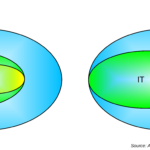Background
There is no question that the last 20 years have witnessed the explosive deployment and grow throughout the globe of the new Information and Communication Technologies (ICTs). This growth has been usually identified with Internet access which, according to the latest statistics, has almost 1.6 billion users -or close to 24% of the world’s population. However, the spread of the coverage is very uneven; for example, only 5% of Africa’s population (55 million people) have access to the Internet.
Needless to say, the new ICTs are larger than the Internet. And they also evolve quite rapidly. It should thus not be surprising that the so-called “Internet Revolution” has been superseded, against all odds and expectations, by a mobile technologies tsunami. Today, over 4 billion people in the globe are using a mobile phone. And Africa has not only close to 350 million users but it is also the fastest growing region in the world. Indeed, this the first time in history that one single technology spreads so fast across the globe. Mobile technologies have done in 15 years that fixed phone lines could not do in almost 120.
In parallel fashion, global poverty has undergone similar positive transformations. In 1990, close to 42% of the world’s population lived in extreme poverty. By 2005, only 25% or 1.4 billion were living on USD 1.25 a day or less, with China making rapid progress (down to 16% from 60% in 1990). However, in sub-Saharan Africa 51% of the total population still lives in extreme poverty – and the current global crisis will surely exacerbate this.
A recent report by UNDP indicates that 4 billion people in the world do not have access to justice and legal systems and services. This is certainly more than those who do not have access to a mobile phone. Or to put it in positive fashion, 300 million people who do not have access to legal systems do have a mobile phone. Can they use the latter to gain access to the former?
Service Delivery, MDGs and ICTs
Although progress has been made, the poorest sections of the global population still lack access to basic services, both private and public. Both governments and the private sector have been unable to reach out to the billions of people who today live in almost sub-human conditions. The Millennium Declaration and the MDGs are an explicit attempt, for the first time in history, by most countries in the world to openly address this challenge. Although the MDGs are larger than just service delivery for the poor, many of its 18 targets fall under such category – the very last one calling for universal access to ICTs. And ICTs have the potential of providing most of these services on a more affordable basis (lower units costs) and on a larger scale.
The use of ICTs to address poverty and development issues is certainly not new. It started almost at the same time as the “Internet Revolution”. This vast experience of success and failures has taught us, perhaps the hard way, that ICTs are just a means and not an end itself. After all, the so-called digital divide, particularly in developing countries, is a reflection of existing economic, social and even political divides. Thus, the critical issue is not to close the “digital divide” but rather to tackle traditional and well-know gaps deploying innovative ICT solutions –keeping in mind at all times that ICTs are not a panacea either.
Governance is a key element for successful and effective service delivery, through the provision pf mechanisms that facilitate Government accountability and transparency.
One of the best examples on the public service side is India’s national e-governance programme -which is usually overshadowed by the well known example of the dynamic ICT sector in the country. This programne, which is essentially a public-private partnership and mostly runs on privately owned Internet kiosks, focuses on providing poor urban and rural dwellers with easy access to government issued documents -such as birth certificates, land titles, etc.- which the poor have a hard time getting and, in many cases, must pay bribes to obtain them. The programme, which is also highly decentralized by state and local municipalities, is now benefiting millions -in the state of Andhra Pradesh alone over 10 million people have seen its benefits.
Mobile technologies are now opening new frontiers in this regard as they allow us to reach sectors of the population who are not on the Internet but have access to a cell phone. In Malawi for example, a project based on SMS networking is now providing basic health information and services to a rural community of close to 250,000 people located 60 kms. from Lilongwe, the Capital. Using recycled phones, the support network working in tandem with the local public hospital have been able to assist people with TB and provide other basic health services to people who otherwise would have never been treated.
Still, reaching the poorest of the poor is still a daunting challenge. Additional efforts in terms of both location (as in local development/local governance) and scale are required in a concerted fashion.
The Millennium Village Project (MVP)
The MVP is one excellent example of the above. With the aim of providing an integrated, cross-sectoral package of programmes to help achieve the MDGs, the MVP is active in 14 sites spread out within 10 countries in sub-Sahara Africa. These sites are in poor rural areas where traditional development approaches and organizations have not been able to make a real dent in tackling the vast socio-economic gaps. [THIS SECTION NEEDS MORE BEEF!]
Although not all sites are exploiting the use of ICTs to improve service delivery, a handful of them are doing so using a wide variety of options ranging from Internet access to innovative use of mobile phones to provide education and health and promote local business development, among others.
Overall Objective of the Project
The main objective of the project is to assess the impact of deploying ICTs in MVP sites to deliver basic services to the poor, with a particular focus on those services, private or public,that are part of MDG established targets. In this context, ICTs include old and new technologies as well as Internet and mobile access, all of which are linked together by gateways that allow broader coverage, communication, and networking for both users and enhanced service provision/information sharing and dissemiantion.
Focus
The assessment will focus on the following elements:
* Type of public/private services being provided
* Technologies being deployed
* Ownership of the process/role of local communities in service prioritazation
* Efficiency of the technologies
* Transparency and accountability of services being provided
* Links to local/national governments and related policies and expected roles
* Scalability and replicability of service provision
* Long term sustainability of ongoing efforts
Working hypothesis
Several working hypothesis can also be tested, including:
* ICT investments reduce units costs of basic services in the medium term (short-term costs might actually increase) and thus increase access
* ICT investments provide the catalytic pillars to expand service provision coverage to large segments of the population
* ICT investments help reduce corruption and foster accountability of service providers
* ICT infrastructure deployment can have the potential of informing local communities better about local policies and services
* ICT infrastructure deployment can increase voice and participation of stakeholders on local decision-making processes
* ICT investments in public services are more sustainable when local governments are part and parcel of the process\
* ICT investments are more effective when they respond to priority demands and needs of local communtiies
Methodology
The MVP broadly focuses on 9 areas of work including: agriculture, local governance and community development, education, environment, health, infrastructure and water and sanitation. Usage of ICTs in these different sectors varies by site. For UNTFHS funded sites for example, ICTs are being mostly used for education and health services, and as an important component of infrastructure investment. Some of the cluster sites however do not use ICTs at all. This provide the ideal environment for also doing some comparative analysis between sites that use ICT for service provision and those that do not.
The MVP has an important M&E component that includes quarterly data collection of 87 indicators covering all 9 sectors as well as 3 household surveys to de implement in 6 years -two of which have apparently been completed by 2009. There is thus an important resourec of primary data that can be used to start the project.
To complement the above, coordinated and well structured field visits to selected MVP sites will be required probably including informal interviews with stakeholders, donors, partners and local governments as well as UNDP offices.
The methodology needs to be further refined.
Deliverables
The project will generate the following products:
* Assessment methodology for ICTs impact on the MDGs and service delivery
* At least two full case studies based on selected MVP sites
* A full report linking case study results and evidence to scaling-up similar programmes and replicating them in other contexts/geographical locations





